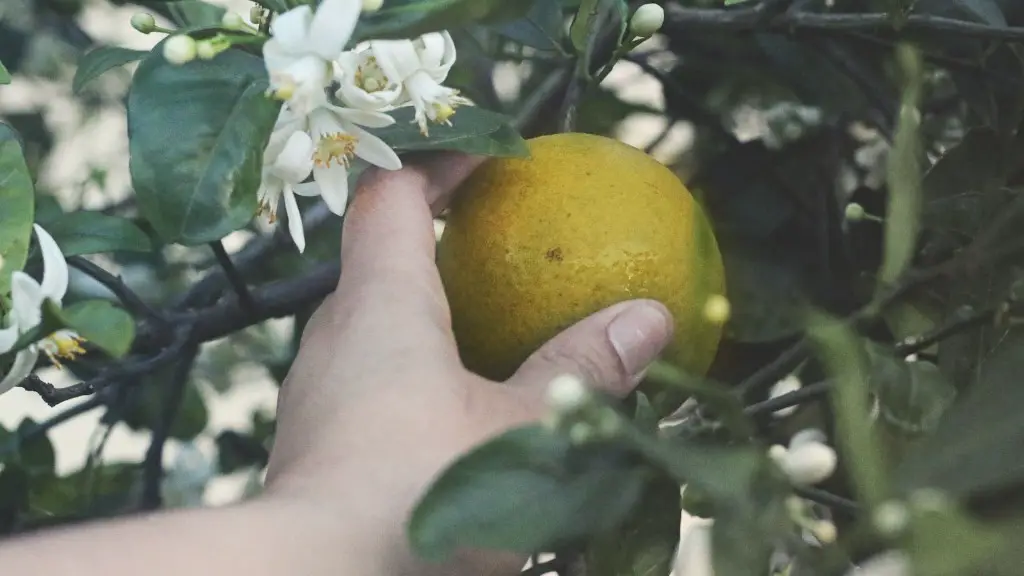Can we grow lemon trees in pots? Yes! Growing lemon trees in pots is a great way to obtain fresh and organic lemons in areas where they do not typically grow. It’s simple but requires a bit of patience, as these trees need plenty of sunlight and care. When done correctly, you’ll be able to enjoy the wonderful aroma of these citrus fruits. Here’s how to do it:
Start by finding a pot that’s large enough for your lemon tree; the bigger, the better. Make sure it has good drainage and make sure it has enough space for the root ball, a few inches (about 5 cm) enough all around the tree. Additionally, choose a location that gets direct sunlight for at least 6 hours a day, such as a balcony or patio.
Plant the tree in high quality, fast-draining potting soil. Amend it with compost if you wish. Once planted, water the tree regularly but not too often; it’s best to let the soil dry out a bit between watering. Maintain soil nutrients with a fertilizer such as slow release fertilizer, seaweed teas, or fish emulsion.
As your tree grows, prune it to make sure it’s healthy and grows evenly. Pruning also encourages the growth of more flowers and fruits. Remove any diseased or dead branches. Regularly remove dead leaves and thin out overcrowded branches for air circulation.
Finally, keep an eye out for pests, such as aphids and whitefly. You can control these by using natural methods such as neem oil or insecticidal soap or by using horticulture oil or homemade garlic water spray.
Lemon Tree Maintenance
Maintaining a lemon tree in a pot requires regular attention. Regularly inspect it for signs of a disease or pests, water it deeply and adequately when needed, prune it to keep its shape, and apply a time-release fertilizer as recommended.
Also, every three years, you should transplant your lemon tree into a bigger pot. This will ensure proper growth and healthy production of fruits. It’s best to do this in early summer. Just make sure you provide enough space around the tree’s root ball and use a potting soil with good drainage.
Moreover, you should use extra caution when the temperature outside drops below 37 degrees Fahrenheit (3 degrees Celsius). Lemon trees can handle temperatures as low as 28 degrees Fahrenheit (-2 degrees Celsius) for brief periods of time, but if the outdoor temperature stays too low, bring the tree indoors and find a warm corner for it.
Likewise, it’s important to protect your lemon tree from strong winds and rains. Make sure to give it adequate attention, as this will help maintain the health of your lemon tree and increase its productivity.
Best Varieties of Lemons for Containers
When choosing the type of lemon tree for growing in a pot, look for a dwarf or a grafted variety that produces smaller fruit. Good choices include ‘Meyer Lemon,’ ‘Little Ollie,’ and ‘Eureka.’ These varieties tend to be smaller and more suitable for growing in a smaller space.
You can also go for the ‘Lemonade’ variety if you’re looking for an ornamental plant as well as lemons. This type produces edible fruit, but its main appeal is its dark green foliage and clusters of white flowers.
‘Ponderosa,’ a lemon-like, grapefruit-sized fruit, is also a good option for a pot. Its fruits are so large that one may weigh up to three pounds (1.5 kg). Its acidic flavor is similar to that of a lime and its fruits have few seeds.
If you’re looking for a lemon to juice, the ‘Lisbon’ variety is a good choice as it is more tolerant to colder temperatures and produces a juicy, sweet-tart fruit with few seeds.
Finally, ‘Variegated Pink’ is a popular ornamental as its leaves have green, yellow and white variegations. While the fruits it produces aren’t ideal for eating, they are quite colorful.
Lemon Tree Needs
Lemon trees need plenty of sunlight and water for optimal growth. If these trees don’t receive enough sun, their leaves will tend to yellow, which indicates chlorosis or nutrient deficiency. In terms of water, it’s best to water the trees deeply and regularly and use a moisture meter to make sure you don’t over- or underwater the plant. In addition, lemon trees need protection from strong winds and occasional fertilizing.
In terms of temperature, lemon trees prefer temperatures between 65 and 85 degrees Fahrenheit (18-29 degrees Celsius). As such, when the temperatures outside get too low, you may need to move the tree indoors or cover it with a frost fabric during cold spells. During winter, it’s best to hydrate the tree every two to three weeks to prevent dehydration.
Lastly, lemon trees also need adequate air circulation in order to thrive. Make sure to prune it regularly so its branches don’t overcrowd and cause an air block. This will encourage healthier growth and greater productivity.
Insects and Pests Control
In order to prevent pests from harming your lemon tree, it’s best to regularly inspect the tree for signs of pests. Common pests include aphids, fruit flies, and whitefly. When noticed, use insecticidal soap or homemade garlic water spray to control them.
In addition, you can regularly spray the tree with a horticultural oil or neem oil, which will prevent insects from infesting it. Nematodes, parasitoid wasps and bug-eating birds can also help control some insect populations. However, if the problem persists, use chemical insecticides, but make sure to use them according to the instructions.
Furthermore, inspect the soil around the tree for mold and fungus. If present, use bicarbonate of soda to neutralize the fungus and make sure to use a fungicide according to the manufacturer’s instructions.
Harvesting and Storing Lemons
When lemons become yellow and soft, they are ready to be harvested. You can also pluck unripe lemons for cooking purposes. To do so, make sure to wear gloves and use sharp scissors or pruners to cut the fruit from the branch without causing any damage.
When harvesting lemons, avoid direct sunlight and keep the fruits in a cool, dry place. Additionally, some lemons can stay on the tree for up to six months, so make sure to check the tree regularly for ripe fruits. You can also store cut lemons in a refrigerator, but make sure to use them within a few days.
In terms of preserving lemons, it’s best to pickle them or preserve them in salt and olive oil. You can also store the lemons in their own juice or freeze them in ice cube trays. However, these methods don’t preserve the lemons for more than a few months.
Finally, if your tree is producing way more lemons than it can handle, you can give away or sell some of the lemons. You can also freeze the juice of the lemons and make jams, jellies, and marmalades. This way, you’ll be able to savor the wonderful flavor of lemons all year round.





